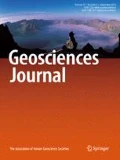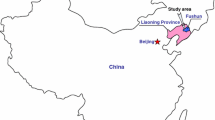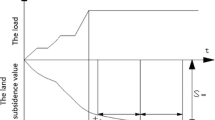Abstract
Mining-induced problems in the coal field seriously threaten the normal operation of the mines and cause significant property losses and environmental disruption. Thus, high precision subsidence prediction is important on the processing of mining subsidence problems. In this paper, we analyzed the formation mechanism of skewed subsidence. The rock beam on the side of the gob and coal pillar presented different supporting reaction force, and the difference resulted in the asymmetric distribution of subsidence velocity, which further led to the formation of the surface skewed subsidence basin. The relationship between the wave curve and vibration curve was determined, and the skewed subsidence process of the surface point in the mining affected area was analyzed. The total duration of the initial and accelerated subsidence phases is smaller than that of the decelerated and end subsidence phases. Then, from the skewed subsidence characteristics, the skewed subsidence prediction model based on the lognormal function was built. An application example was selected to validate the feasibility and effectiveness of the proposed model. Results showed that the model has good prediction ability.
Similar content being viewed by others
References
Bell, F.G., Stacey, T.R., and Genske, D.D., 2000, Mining subsidence and its effect on the environment: some differing example. Environmental Geology, 40, 135–152.
Cui, X.M., Gao, Y.G., and Yuan, D.B., 2014, Sudden surface collapse disasters caused by shallow partial mining in Datong coalfield, China. Natural Hazards, 74, 911–929.
Dai, H.Y. and Wang, J.Z., 2003, Prediction model for surface movement and deformation induced by sub-critical extraction. Journal of China coal society, 28, 583–587.
Dai, H.Y., Zhai, J.C., and Hu, Y.J., 2000, Testing study on the surface displacement of mountainous regions with similar material. Chinese Journal of Rock Mechanics & Engineering, 4, 501–504.
Fan, G.W., Zhang, D.S., and Ma, L.Q., 2011, Overburden movement and fracture distribution induced by longwall mining of the shallow coal seam in the Shendong coalfield. Journal of China University of Mining & Technology, 40, 196–201.
Fan, L.M., Ma, X.D., and Ji, R.J., 2015, The progress of research engineering practice of water-preserved coal mining in western ecoenvironment frangible area. Journal of China Coal Society, 40, 1711–1717.
He, G.Q., Yang, L., Ling, G.D., Jia, F.C., and Hong, D., 1991, Mining Subsidence Theory. China University of Mining and Technology Press, Xuzhou, 240 p.
Holla, L., 1997, Ground movement due to longwall mining in high relief areas in New South Wales, Australia. International Journal of Rock Mechanics & Mining Sciences, 34, 775–787.
Ju, J.F. and Xu, J.L., 2015, Surface stepped subsidence related to top-coal caving longwall mining of extremely thick coal seam under shallow cover. International Journal of Rock Mechanics and Mining Sciences, 78, 27–35.
Kratzsch, H., 1983, Mining Subsidence Engineering. Springer, Berlin, 537 p.
Liu, B.C., 1982, Introduction of Mining Rock Mechanics. Hunan sciences & technology Press, Changsha, 310 p.
Lu, B.W., Liu, C.W., Liu, D.F., Gao, Y.R., and Wang, Y., 2016, Research on the roof strata moving law in shallow thin bedrock with 3D physical simulation experiment. Journal of Sichuan University (Engineering Science Edition), s1, 107–113.
Luo, Y. and Cheng, J.W., 2009, An influence function method based subsidence prediction program for longwall mining operations in inclined coal seams. Mining Science and Technology, 19, 0592–0598.
Ma, L., Zhang, D., Sun, G., Cui, T., and Zhou, T., 2013, Thick alluvium full-mechanized caving mining with large mining with large mining height face roof control mechanism and practice. Journal of China Coal Society, 38, 199–203.
Peng, S.S., 1978, Coal Mine Ground Control. Wiley, New York, 158 p.
Ramesh, P.S. and Ram, N.Y., 1995, Prediction of subsidence due to coal mining in Raniganj coalfield, West Bengal, India. Engineering Geology, 39, 103–111.
Ren, G., Whittaker, B.N., and Reddish, D.J., 1989, Mining subsidence and displacements prediction using influence functions methods for steep seams. Mining Science and Technology, 8, 235–252.
Sinha, S., Bhattacharya, R.N., and Banerjee, R., 2007, Surface iron ore mining in eastern India and local level sustainability. Resources Policy, 32, 57–68.
Saha, S., Pattanayak, Sk., Sills, Eo., 2011, Under-mining health: environmental justice and mining in India. Health Place, 17, 140–148.
Salmi, E.F., Nazem, M., and Karakus, M., 2017, The effect of rock mass gradual deterioration on the mechanism of post-mining subsidence over shallow abandoned coal mines. International Journal of Rock Mechanics and Mining Sciences, 91, 59–71.
Sasaoka, T., Takamoto, H., Shimada, H., Oya, J., Hamanaka, A., and Matsui, K., 2015, Surface subsidence due to underground mining operation under weak geological condition in Indonesia. Journal of Rock Mechanics and Geotechnical Engineering, 3, 337–344.
Tang, F.Q., 2009, Research on mechanism of mountain landslide due to underground mining. Journal of Coal Science & Engineering, 15, 351–354.
Wang, J.C. and Wang, Z.H., 2015, Stability of main roof structure during the first weighting in shallow high-intensity mining face with thin bedrock. Journal of Mining & Safety Engineering, 2, 175–181.
Wang, J.Z., Kang, J.R., and Chang, Z.Q., 1999, The mechanism analysis on the dissymmetry of the surface subsidence basin. Journal of China coal society, 24, 252–255.
Wang, S.M., Huang, Q.X., and Fan, L.M., 2010, Coal Exploitation and Ecological Water Level Protection in Ecological Fragile Area. Science Press, Beijing, 208 p.
Wang, X.Z., Xu, J.L., Zhu, W.B., and Ju, J.F., 2012, Influence of high mining velocity on periodic weighting during fully-mechanized mining in a shallow seam. Journal of China University of Mining & Technology, 41, 349–355.
Xuan, Y.Q., 2008, Research on movement and evolution law of breaking of overlying strata in shallow coal seam with a thin bedrock. Rock and Soil Mechanics, 29, 512–516.
Yu, B., Zhao, J., Kuang, T.J., and Meng, X.B., 2015, In situ investigations into overburden failures of a super-thick coal seam for longwall top coal caving. International Journal of Rock Mechanics and Mining Sciences, 78, 155–162.
Zhang, J. and Chong, L., 2012, The discussion of the surface and building deformation in the coal mining subsidence area. Shanxi Architecture, 38, 83–84.
Author information
Authors and Affiliations
Corresponding author
Rights and permissions
About this article
Cite this article
Yan, W., Chen, J. & Yan, Y. A new model for predicting surface mining subsidence: the improved lognormal function model. Geosci J 23, 165–174 (2019). https://doi.org/10.1007/s12303-018-0008-1
Received:
Accepted:
Published:
Issue Date:
DOI: https://doi.org/10.1007/s12303-018-0008-1




